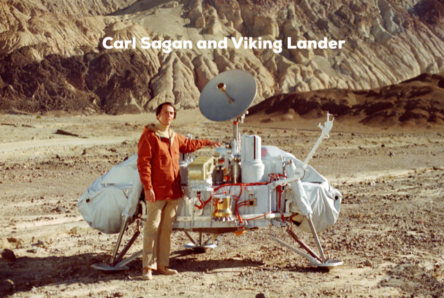 • SEPT 2 – Viking 2 lands on Mars. NASA’s Viking Project consisted of two space probe missions to the Red Planet. Each probe consisted of an orbiter that would survey the planet from above, while a lander would analyze the composition of the Martian soil as well as conduct a number of biology experiments. The soil analysis revealed about what you might expect to form from the weathering of basaltic rocks. But the biology experiment results is what really caused folks to set up and take notice. Viking 2 did not detect any organic compounds in the soil, but out of the four biology tests done, there were two negative and two positives. The positive results have now been interpreted to be false positives that were likely produced by inorganic chemical processes in the soil. There are some scientists who still believe that those positive results could have been due to biological activity. Perhaps future missions will yield more definitive results. The Viking Project was NASA’s first mission dedicated to looking for life on another planet.
• SEPT 2 – Viking 2 lands on Mars. NASA’s Viking Project consisted of two space probe missions to the Red Planet. Each probe consisted of an orbiter that would survey the planet from above, while a lander would analyze the composition of the Martian soil as well as conduct a number of biology experiments. The soil analysis revealed about what you might expect to form from the weathering of basaltic rocks. But the biology experiment results is what really caused folks to set up and take notice. Viking 2 did not detect any organic compounds in the soil, but out of the four biology tests done, there were two negative and two positives. The positive results have now been interpreted to be false positives that were likely produced by inorganic chemical processes in the soil. There are some scientists who still believe that those positive results could have been due to biological activity. Perhaps future missions will yield more definitive results. The Viking Project was NASA’s first mission dedicated to looking for life on another planet.
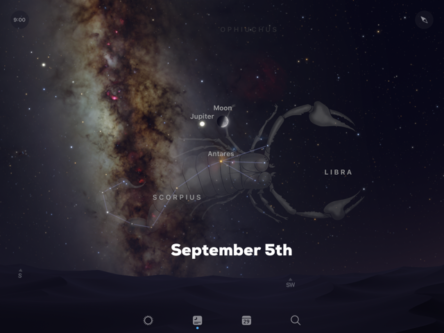 • SEPT 5 -Look for the First Quarter moon tonight with Jupiter just a few degrees to its east.
• SEPT 5 -Look for the First Quarter moon tonight with Jupiter just a few degrees to its east.
• SEPT 8 – Gene Roddenberry’s Star Trek debuted on NBC with the episode, “The Man Trap”. It’s depiction of a hopeful future in which equality, tolerance, compassion, and reason prevails, has inspired millions all around the world. There are a great many activists, authors, filmmakers, scientists, engineers, doctors, and astronauts who have been inspired by its message. Star Trek became an enduring franchise that has persisted to this day with movies, various TV spinoff series, and all new television series such as Star Trek: Discovery and the upcoming, Star Trek: Picard.
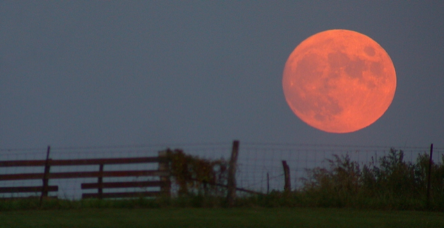
• SEPT 13 – Begin looking for the Harvest Moon tonight, rising at sunset. A Harvest Moon is the name given to a full moon that occurs within two weeks of either side of the autumnal equinox (the first day of fall). Most years, the Harvest Moon is in September, but it can also occur in early October other years. Why is the Harvest Moon so special? Honestly, it’s the same old moon that orbits around the Earth throughout the rest of the year, but there is something a bit unique about it right now.
The moon is always on the move as it orbits around the Earth and its orbital motions make it appear to be drifting eastward upon the sky from one night to the next, relative to the background constellations that make up the zodiac. The zodiac is the set of constellations that the Sun, moon, and planets appear to move through upon the sky over the course of a year. We call this path across the sky, the ecliptic (SPOILER ALERT: it’s also the place upon the sky where you might get to see an eclipse of one sort or another) and the constellations of the zodiac inhabit it. In reality, this pathway across the sky is the plane of our solar system as we see it, edge on, from here on Earth.
Go out on any other night (or day) and pay attention to when the moon rises and which constellation it is in as it does so. Then, go back outside 24 hours later and you will discover that the moon is no longer there. In fact, it hasn’t even risen yet. You will have to wait about 50 minutes more so that the Earth can rotate upon its axis and then “catch up to” the moon upon the sky. Not only is the rise time different from night to night, but the moon is also occupying another constellation each night as it chugs along in its orbit. As the moon drifts eastward from night to night, it covers about 12 degrees of sky and this translates into an average 50- minute difference between successive moonrises. But around the time of the autumnal equinox, the ecliptic and the zodiac form a shallow angle with the eastern horizon. This is rather convenient since it means that the Earth does not need to rotate very far in order to catch up to the moon upon the sky. So, rather than wait 50 minutes for the moon to rise over the next few evenings, you will see as little as 23 minutes between successive moonrises. In days of old, this meant some extra light at night so that you could work late in order to harvest your crops. Shine on, y’all!
• SEPT 14 – Full Harvest Moon tonight
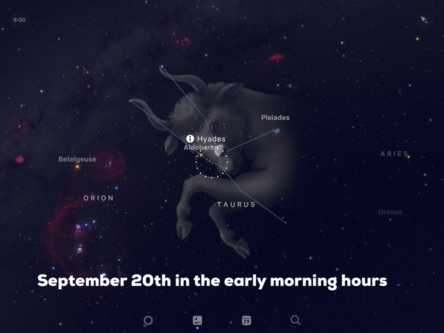
• SEPT 20 – The waning gibbous moon can be seen just above the Hyades star cluster in the constellation of Taurus. The glare from the moon will mask many of the faint stars in this cluster, which form a V-shaped pattern representing the face of the bull, but use a pair of binoculars to view them on a moonless night, you will see a lovely, and dazzling array of stars spanning an area upon the sky as wide as your fist held out at arm’s length.
According to mythology, the Hyades were half-sisters to the Pleiades sisters (their star cluster can be seen just to the west of the Hyades). The father of the Hyades sisters was the Titan, Atlas, while their mother is said to be Aethra, one of the 3,000 daughters born to the Titans Oceanus and Tethys. The Hyades sisters had one brother, Hyas, and when he was killed in a hunting misadventure, they began to weep uncontrollably. Zeus decided to place the sisters among the stars and their tears brought rain to the Earth.

• SEPT 21 – The moon is at last quarter.
H.G. Wells, author of such science fiction classics as The Time Machine, The First Men In The Moon, The War Of The Worlds, The Invisible Man, The Island Of Dr. Moreau and others, was born on this day in 1866.
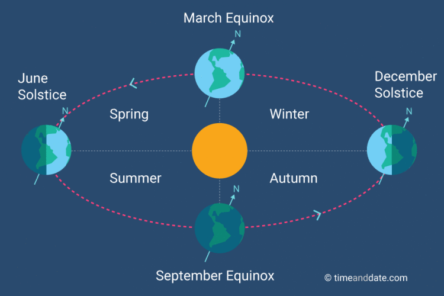
• SEPT 23 – The autumnal equinox officially begins in the northern hemisphere at 2:50 AM. The planet Earth is tilted upon its axis by 23.5 degrees, relative to its orbital plane around the Sun. Which season is occurring in either of the Earth’s hemispheres is determined by this axial tilt. For example, during the northern hemisphere’s winter, our portion of the globe is titled away from the Sun. At this time, we receive less of the Sun’s direct rays and, so, we experience winter. Meanwhile, the opposite is true in the southern hemisphere, which is tilted more towards the Sun, getting more direct sunlight, and, so, they experience summer.
On the spring and fall equinoxes, the Earth is at a point in its orbit where the axis is neither tilted towards or away from the Sun. Since the Earth’s axis is now more or less perpendicular to the Sun’s rays, each hemisphere will experience nearly equal amounts of day and night (roughly 12 hours each). In fact, the word “equinox” is derived from the Latin “equal night”.
• SEPT 28 – The moon is now at New Phase.